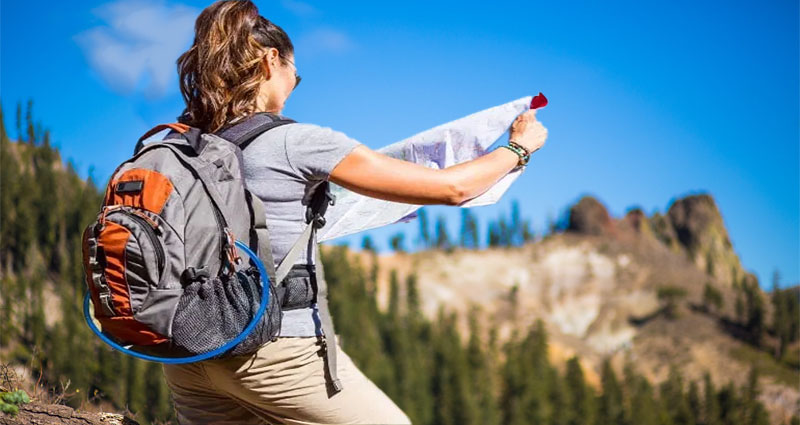Embarking on an outdoor adventure can be a thrilling and rewarding experience. Whether you’re planning a day hike, a camping trip, rock climbing, or any other outdoor activity, having the right equipment and tools is essential to ensure your safety and enhance your overall experience. Proper preparation can make the difference between a successful adventure and a potentially dangerous situation. Here, we’ll outline the necessary equipment and tools you should pack before heading out into the great outdoors.
- Navigation Tools: Knowing where you are and where you’re going is paramount. Carry a detailed map of the area, a compass, or even better, a GPS device. Familiarize yourself with the terrain and trail markers, and if you plan to rely on a smartphone, ensure you have offline maps and a portable charger.
- First Aid Kit: Accidents can happen, even on the easiest of trails. A well-stocked first aid kit should be one of the first things you pack. It should include bandages, gauze, antiseptic wipes, adhesive tape, pain relievers, tweezers, scissors, and any personal medications you may need.
- Shelter and Sleeping Gear: Even if you’re only planning a day hike, it’s wise to pack emergency shelter equipment such as a lightweight tent or a bivy sack. If you’re camping, ensure you have a suitable tent, sleeping bag, and sleeping pad to stay warm and comfortable during the night.
- Proper Clothing: Dressing appropriately for the weather is crucial. Check the forecast and be prepared for any changes in conditions. Invest in moisture-wicking, quick-drying, and layerable clothing to adapt to temperature fluctuations. Don’t forget to bring a waterproof jacket, hat, gloves, and extra socks.
- Hydration Supplies: Staying hydrated is vital during any outdoor activity. Carry an adequate supply of water and consider using a hydration bladder or water bottles. If you’re planning an extended trip, pack water purification tools like water filters or water purification tablets to access safe drinking water from natural sources.
- Nutritious Food and Snacks: Pack enough food to sustain you during your adventure. Opt for lightweight, high-energy snacks, and easy-to-prepare meals. Consider bringing a portable stove or campfire equipment for cooking.
- Illumination: A reliable headlamp or flashlight with extra batteries is a must, especially if you plan to be out after dark. It’s important to have a hands-free source of light for navigating, setting up camp, or dealing with emergencies.
- Multi-Tool or Knife: A versatile multi-tool or a sturdy knife can be incredibly useful for various tasks such as preparing food, repairing gear, and creating tinder for starting a fire.
- Fire-Starting Equipment: In emergency situations, being able to start a fire is crucial for warmth, cooking, and signaling for help. Pack waterproof matches, a butane lighter, or fire-starting tools like a fire starter rod.
- Communication Devices: Carry a charged cellphone as a primary means of communication, but don’t solely rely on it, as coverage may be limited in remote areas. Consider bringing a satellite communicator or a personal locator beacon (PLB) for reliable communication in emergency situations.
- Sun Protection: Shield yourself from the sun’s harmful rays by wearing a broad-brimmed hat, sunglasses, and sunscreen with high SPF. Sunburn and heatstroke can quickly ruin an otherwise great adventure.
- Repair Kit and Duct Tape: Accidents can happen to your gear, so having a basic repair kit with items like duct tape, patch kits for tents/sleeping bags, and sewing materials can save the day.
- Waste Disposal Supplies: Always leave nature as you found it. Pack trash bags to carry out your waste, and consider bringing a small trowel for burying human waste responsibly.
- Insect Repellent: Depending on the location and time of year, insects can be a significant nuisance. Carry insect repellent to protect yourself from bites and potential diseases.
- Knowledge and Training: Having the right equipment is essential, but knowing how to use it effectively is equally important. Take the time to educate yourself on outdoor skills, such as navigation, first aid, and wilderness survival techniques. Enroll in courses or go on guided trips if you’re new to outdoor adventures. You need to carry firearm like gun with 12 gauge ammo for personal security in wild.
Before embarking on your outdoor adventure, inform someone you trust about your plans, including your intended route and return time. This way, they can alert authorities if you don’t return as scheduled.
Conclusion:
In conclusion, a safe and successful outdoor adventure requires thorough preparation and the right equipment. By packing navigation tools, first aid supplies, shelter, clothing, hydration, illumination, and other essential items, you can better enjoy your outdoor experience while ensuring your safety and well-being. Respect nature, follow Leave No Trace principles, and be prepared for the unexpected, and you’ll be ready for an unforgettable outdoor adventure.








